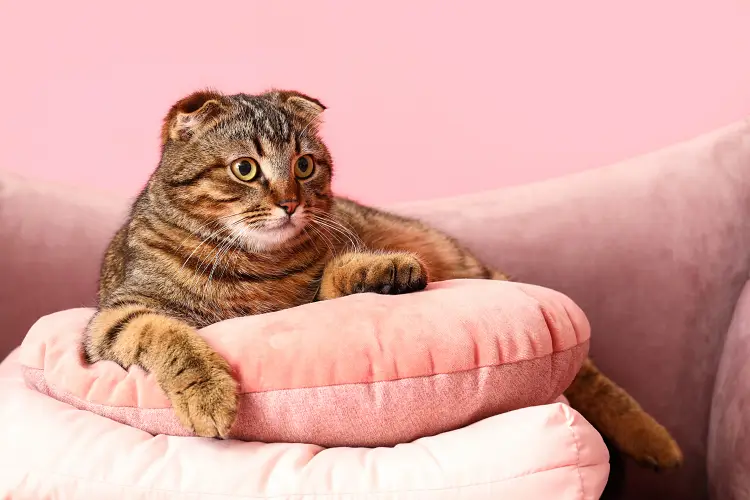With their trademark folded ears and sweet-natured personality, the Scottish Fold is an affectionate cat who is great with people and enjoys spending time with their family.

Scottish Fold Cat Personality
The Scottish Fold breed is friendly, easy-going and adapts well to any home situation – they enjoy the company of adults but they also get on well with children and other cats and dogs.
They are devoted rather than overly demanding and enjoy spending time in your company. They can be playful on occasions, but are more likely to want to curl up in your lap, or sit beside you. They are true couch potatoes and are known for their habit of flopping on their backs and falling sound asleep in this position.
Not exceptionally talkative, the Scottish Fold tends to have a low-key meow and only talks to their humans when they have something to say. The ‘silent meow’ is common amongst this breed – they’ll open their mouth and mime a meow, but no sound actually comes out. They typically use non-verbal means of communication to display their affection, such as jumping onto your lap to say hello.
History
Scottish Folds can trace their origins back to a white barn cat with folded ears named Susie who was discovered by William and Mary Ross on a neighbouring farm in Tayside, Scotland, in 1961. They adopted a white kitten from Susie’s litter who they named Snooks, and who subsequently had a male kitten named Snowball, who they starting a breeding program with using British Shorthairs and farm cats. The litter fathered by Snowball included five folded ear kittens, and the Scottish Fold breed was born.
Originally, the cats were called ‘lops’ after lop-eared rabbits, but in 1966 they were renamed Scottish Folds in reference to their origin and distinctive folded ears.

Did You Know?
Scottish Fold kittens are not born with folded ears; in fact they have straight ears at birth. The ears of kittens that carry the folded ear gene begin to fold at 3-4 weeks of age. There are also different degrees of ear folding – ‘capped-to-the-head’ fold is the most sought after for show cats.
They are often described as owl-like or sometimes as an ‘owl in a cat suit’, due to their folded ears and large round expressive eyes.

Caring for Your Scottish Fold Cat
Like their barn cat ancestors, the Scottish Fold is a fairly robust breed who is easily cared for. Their coat is dense and resilient and easy to maintain with weekly brushing to remove loose hairs. If you have a long-haired Scottish Fold you will need to brush your cat 3-4 times a week to prevent matting and keep them in good condition.
The folded nature of the Scottish Fold’s ears means that they have a tendency to build up wax. You will need to check their ears weekly and clean them as needed.
It is worth noting that when two folded eared cats are bred together the gene that causes the ears to fold can also result in spinal, hind leg and tail deformities. Reputable breeders though, will only breed folded ear with straight ear cats to avoid development of joint problems or deformities in the breed.



Leave a Reply